Tennessee made national news this week for its drug-testing program of welfare applicants.
Since the Department of Human Resources implemented a program in July 2014 to ask applicants about potential drug use and refer those answering yes for urine testing, just 65 tested positive. Another 116 declined to answer and thus were not eligible for benefits. The testing costs the state $23,592.
Much has been made of the small percentage of positive drug tests: One in every 601 applicants, or less than 0.02 percent. Even if one includes the 116 who declined the drug form, drug use among the 39,121 applicants in 18 months would tally about 1 in 216 people - less than half of 1 percent.
But this fact shouldn't be the big shocker.
The surprise in these statistics is actually the tiny number of people applying for Temporary Assistance for Needy Families - known in Tennessee as the Families First program.
Tennessee has a population of 6.3 million. And 39,121 Tennesseans - most with children in their home - applied for family assistance over a year and a half.
That's less than 1 percent of the population - 0.6 percent, in fact.
Here are some additional welfare myth-busters:
* About 1 in 7 welfare recipients in Tennessee also work. In fact, those working caretakers are required to work or be in job training at least 30 hours a week unless they are child caretakers who are 65 years old or older, disabled, temporarily incapacitated, caring for an in-home disabled relative, the single parent caretaker of an infant under age 1, or part of a two-parent household caring for an infant less than 16 weeks old. There is a lifetime limit of 60 months enrollment.
* These working caretakers had an average monthly wage of just over $900, and they received monthly welfare benefits averaging $165.
* Throughout 2015, the number of Families First welfare recipient households dropped each month, and by December that number had fallen to 31,978. The downward trend has continued into 2016, according to a department spokeswoman.
* In December, more than half of the 72,193 beneficiaries in those 31,978 households receiving this assistance - 38,086 - were white, according to the department spokeswoman.
The drug stereotype is just one more misunderstanding of what life is really like in poverty.
The liberal "Think Progress" reports that programs around the country have found similar results. In Missouri, $336,297 was spent and 48 people tested positive; in Utah, $64,566 was spent and 29 people tested positive.
While it is true that the program might help some drug users to find their way to treatment, Think Progress also points out that preventing 180 or so drug users from receiving welfare benefits might come at a larger cost.
"It can increase the shame people feel around applying for welfare benefits in the first place, which could drive them away from getting assistance they may need to get by. At the same time, it may make drug users less willing to disclose and therefore keep them from connecting with treatment."
But it really begs the question of spending our money wisely.
Is the state's $23,592 bill for drug testing doing anything other than eating up what could be a month's utility bill payment or another sack of groceries for about 142 needy families?
